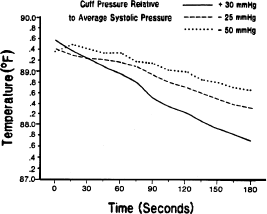
bilateral symmetry. Skin temperature differences from one side of the
body compared to the other are not only extremely small, but also very
stable, and unaffected by the age of the patient. Data show differences
between sides at the forehead to be 0.12°C at the forehead, and 0.25°
at the lumbar region of the back. This symmetry forms the foundation
for clinical interpretation of the varying surface temperature data.
In general, it is the relative readings between the body surface tem-
peratures that are of interest. Hence, the general principle is all detec-
tion is by exception. Accordingly, the temperature data from the nor-
mal or reference area can then be used to adjust for the circadian varia-
tions and for variations in the ambient temperature.
The change in body surface temperature with compromised blood flow
is profound. A recent study was undertaken to mimic both partial and
complete occlusion of blood flow to an extremity. The results indicate
changes in skin surface temperature of an extremity reflect blood flow
interruption or alteration in blood flow to that extremity.
A baseline for systolic blood pressure was determined for each subject
and the manometer cuff inflated to three levels, 30 mmHg above sys-
tolic, 25 mmHg below systolic and 50 mmHg below systolic, with tem-
perature readings taken on the inside wrist at 15 second intervals. Even
at the lowest cuff pressure, there is a clear indication at the end of three
minutes of the surface temperature change due to the lowered tissue
perfusion caused by the reduction in arterial blood flow. The data also
indicate the time between occlusion or partial occlusion and a measur-
able temperature drop is very short, well under one minute.
The surface temperature read-
ings of the human body tend
to be quite close between the
bilaterally symmetric surfaces
of region because of perfusion
symmetry, but vary by several
degrees on different body lo-
cations because of perfusion
differences. Both the hands
and the feet can be substan-
tially colder than the rest of the
body surface due to vasomo-
tor constriction of arterio-
venous shunts as a ther-
moregulatory response.
Effect of blood flow on body surface
temperature
19
